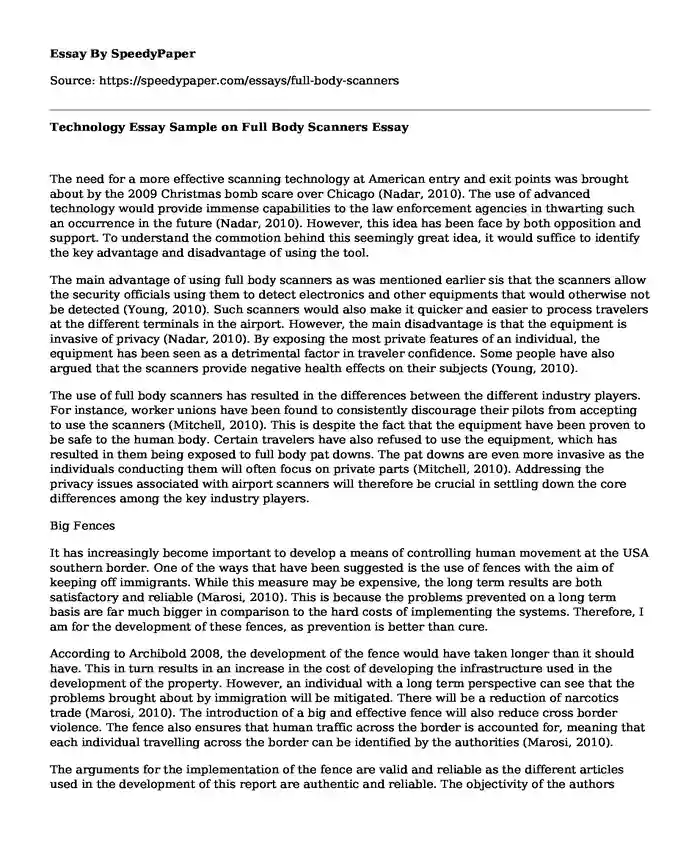
| Type of paper: | Essay |
| Categories: | Terrorism Technology Security |
| Pages: | 3 |
| Wordcount: | 769 words |
The need for a more effective scanning technology at American entry and exit points was brought about by the 2009 Christmas bomb scare over Chicago (Nadar, 2010). The use of advanced technology would provide immense capabilities to the law enforcement agencies in thwarting such an occurrence in the future (Nadar, 2010). However, this idea has been face by both opposition and support. To understand the commotion behind this seemingly great idea, it would suffice to identify the key advantage and disadvantage of using the tool.
The main advantage of using full body scanners as was mentioned earlier sis that the scanners allow the security officials using them to detect electronics and other equipments that would otherwise not be detected (Young, 2010). Such scanners would also make it quicker and easier to process travelers at the different terminals in the airport. However, the main disadvantage is that the equipment is invasive of privacy (Nadar, 2010). By exposing the most private features of an individual, the equipment has been seen as a detrimental factor in traveler confidence. Some people have also argued that the scanners provide negative health effects on their subjects (Young, 2010).
The use of full body scanners has resulted in the differences between the different industry players. For instance, worker unions have been found to consistently discourage their pilots from accepting to use the scanners (Mitchell, 2010). This is despite the fact that the equipment have been proven to be safe to the human body. Certain travelers have also refused to use the equipment, which has resulted in them being exposed to full body pat downs. The pat downs are even more invasive as the individuals conducting them will often focus on private parts (Mitchell, 2010). Addressing the privacy issues associated with airport scanners will therefore be crucial in settling down the core differences among the key industry players.
Big Fences
It has increasingly become important to develop a means of controlling human movement at the USA southern border. One of the ways that have been suggested is the use of fences with the aim of keeping off immigrants. While this measure may be expensive, the long term results are both satisfactory and reliable (Marosi, 2010). This is because the problems prevented on a long term basis are far much bigger in comparison to the hard costs of implementing the systems. Therefore, I am for the development of these fences, as prevention is better than cure.
According to Archibold 2008, the development of the fence would have taken longer than it should have. This in turn results in an increase in the cost of developing the infrastructure used in the development of the property. However, an individual with a long term perspective can see that the problems brought about by immigration will be mitigated. There will be a reduction of narcotics trade (Marosi, 2010). The introduction of a big and effective fence will also reduce cross border violence. The fence also ensures that human traffic across the border is accounted for, meaning that each individual travelling across the border can be identified by the authorities (Marosi, 2010).
The arguments for the implementation of the fence are valid and reliable as the different articles used in the development of this report are authentic and reliable. The objectivity of the authors displays a lack of biasness towards the topic. However, the arguments against the implementation of this idea are clearly biased as they do not delve into the positive aspect of the very actions they advise against. For instance, arguing that because America does not have a fence in its northern border is a reason for not setting up a border in the south is biased (Deans, 2007).
References
Archibold, R. C. (2008, September 11). Border fence is not likely to be done by years end; [National Desk]. New York Times (Late edition (east coast)), A16. Document ID: 1552324261
Deans, B. (2007, November 7). Chertoff says new fence is keeping out immigrants; More than a third of the U.S.-Mexico barrier is up, and illegal entries are down; [Final Edition]. Orlando Sentinel, A4. Document ID: 1378630671
Marosi, R. (2010, February 15). Fencing off forbidden land; Critics of $58-million barrier say the terrain itself keeps immigrants out of Otay Mountain. Los Angeles Times, AA1. Document ID: 1963282797
Mitchell, J. (2010, November 9). U.S. news: U.S. adds certain toner, ink cartridges to the No-Fly List. Wall Street Journal (Eastern Edition), A3. Document ID: 2183603441
Nadar, R. (2010, November 18). TSAs naked insecurity: Public backlash to scanners and pat-downs will continue to grow until Homeland Security addresses real concerns. USA Today, A11. Document ID: 2191471671
Young, A. (2010, November 15). Homeland chief asks fliers for patience; defends body scans as air travelers push back. USA Today, A1. Document ID: 2188814761
Cite this page
Technology Essay Sample on Full Body Scanners. (2021, Jan 25). Retrieved from https://speedypaper.net/essays/full-body-scanners
Request Removal
If you are the original author of this essay and no longer wish to have it published on the SpeedyPaper website, please click below to request its removal:
- Essay Example for Free: New Economy Research
- Essay Sample on Regulating Advertising Practices
- Communication Skills for Nurses and Midwives, Free Essay
- Essay Sample on The Flapper Counterculture
- Free Essay. Literature Review on Fatherhood
- Give Me the Wall; I'll Give You Dreamers. Paper Example
- Access over Excel - Essay Example
Popular categories




